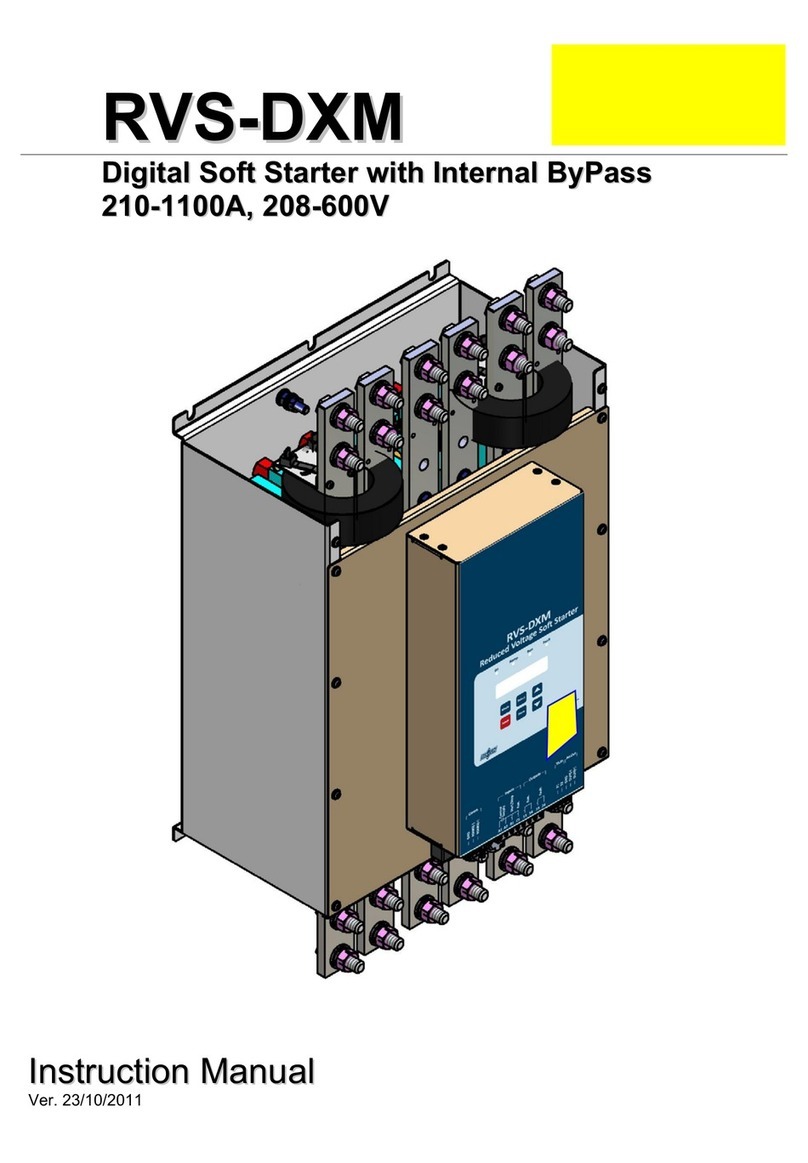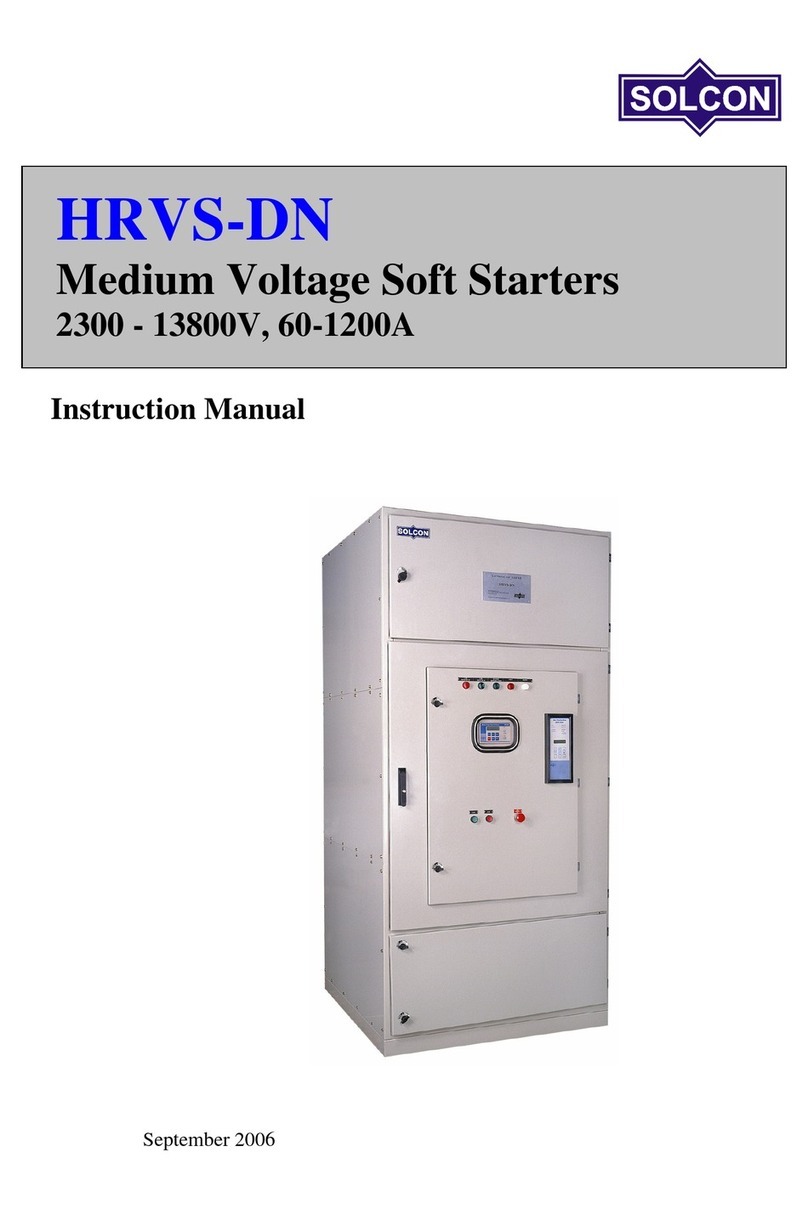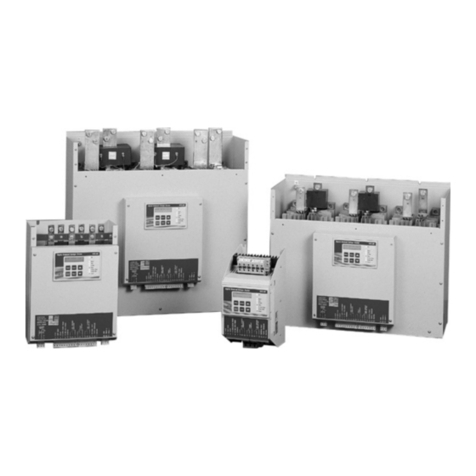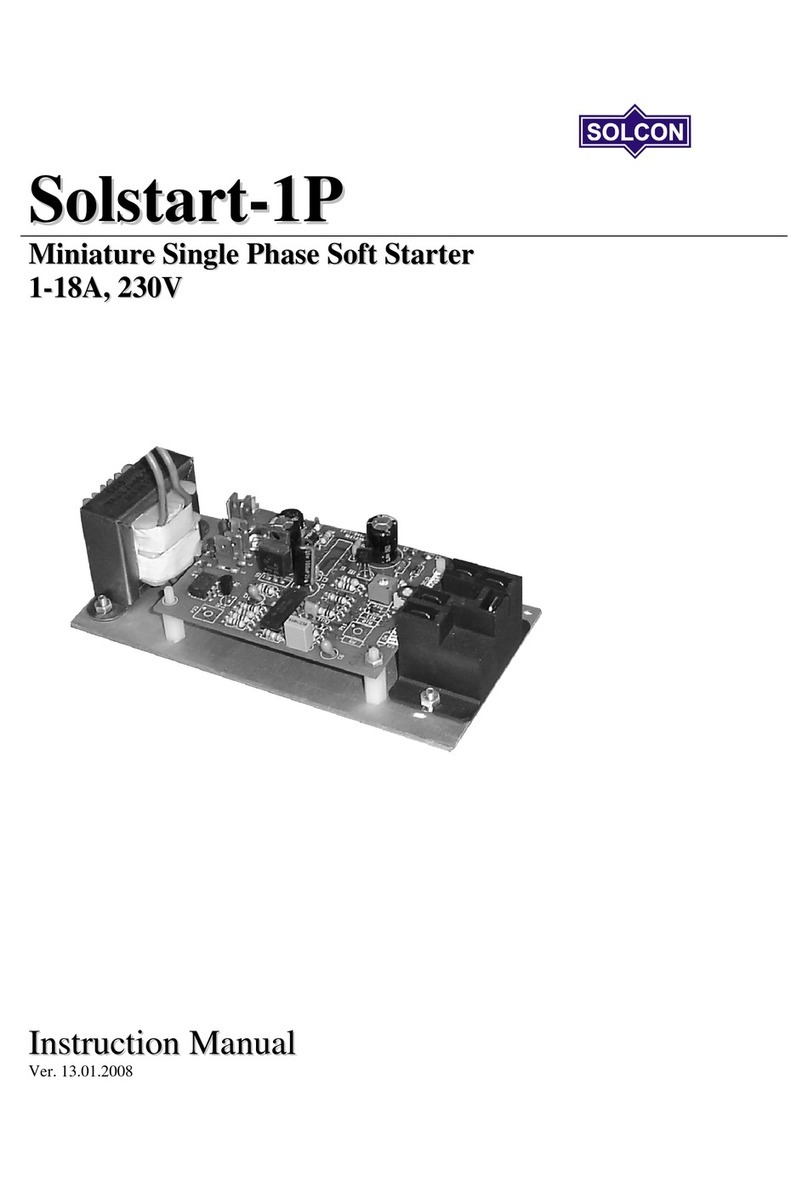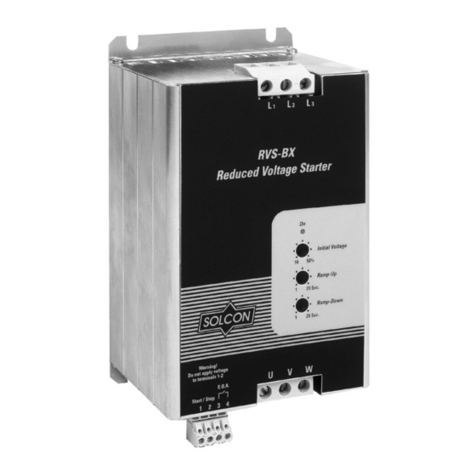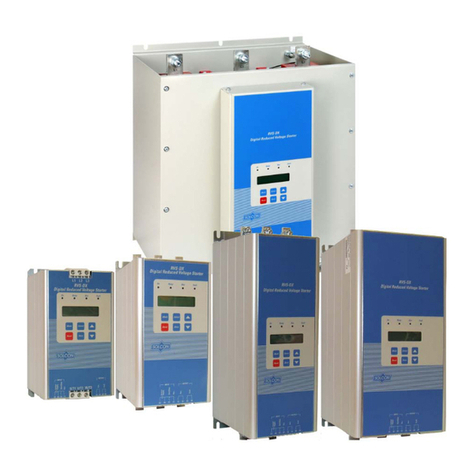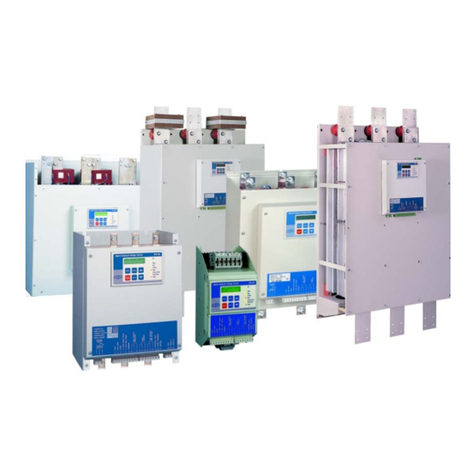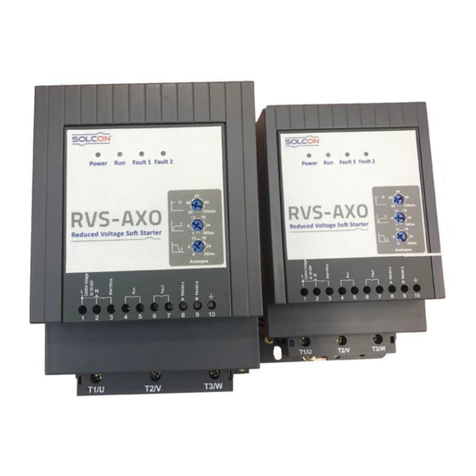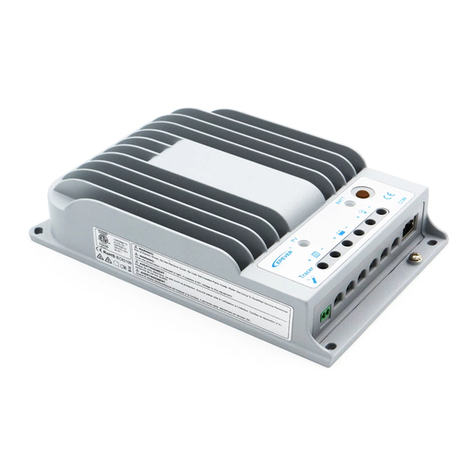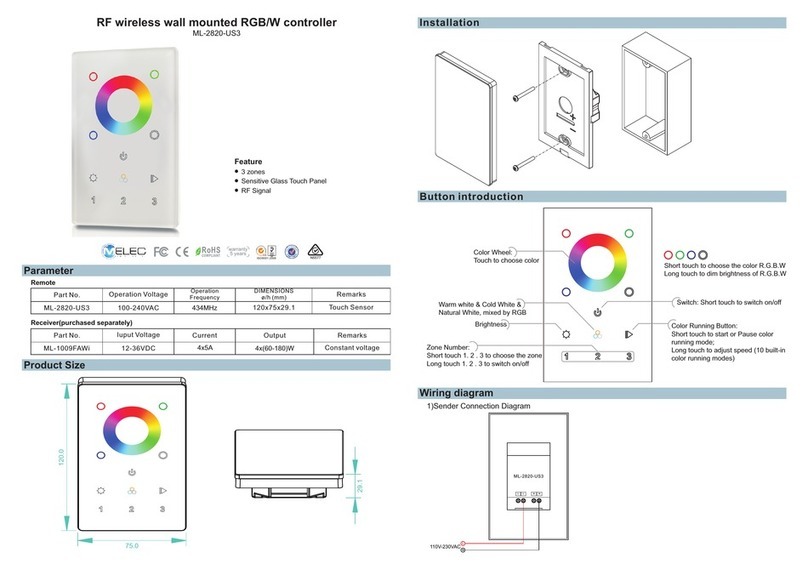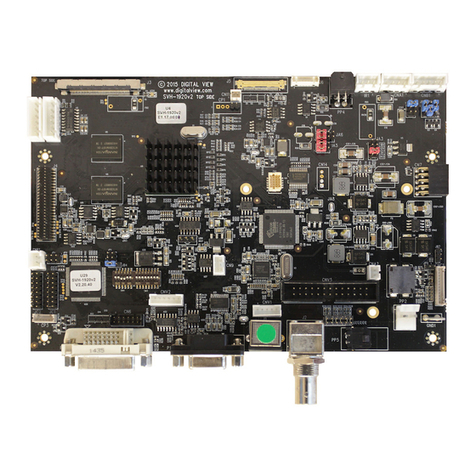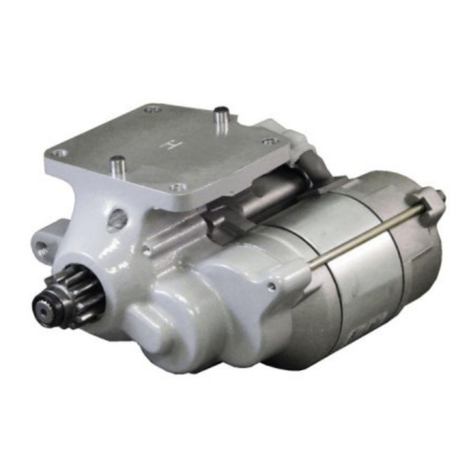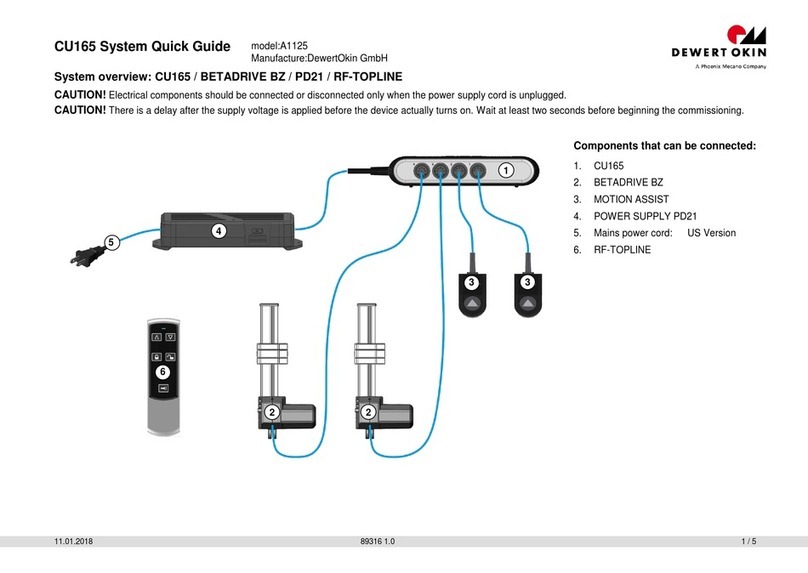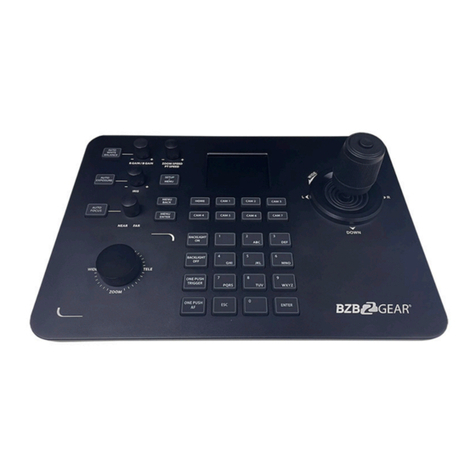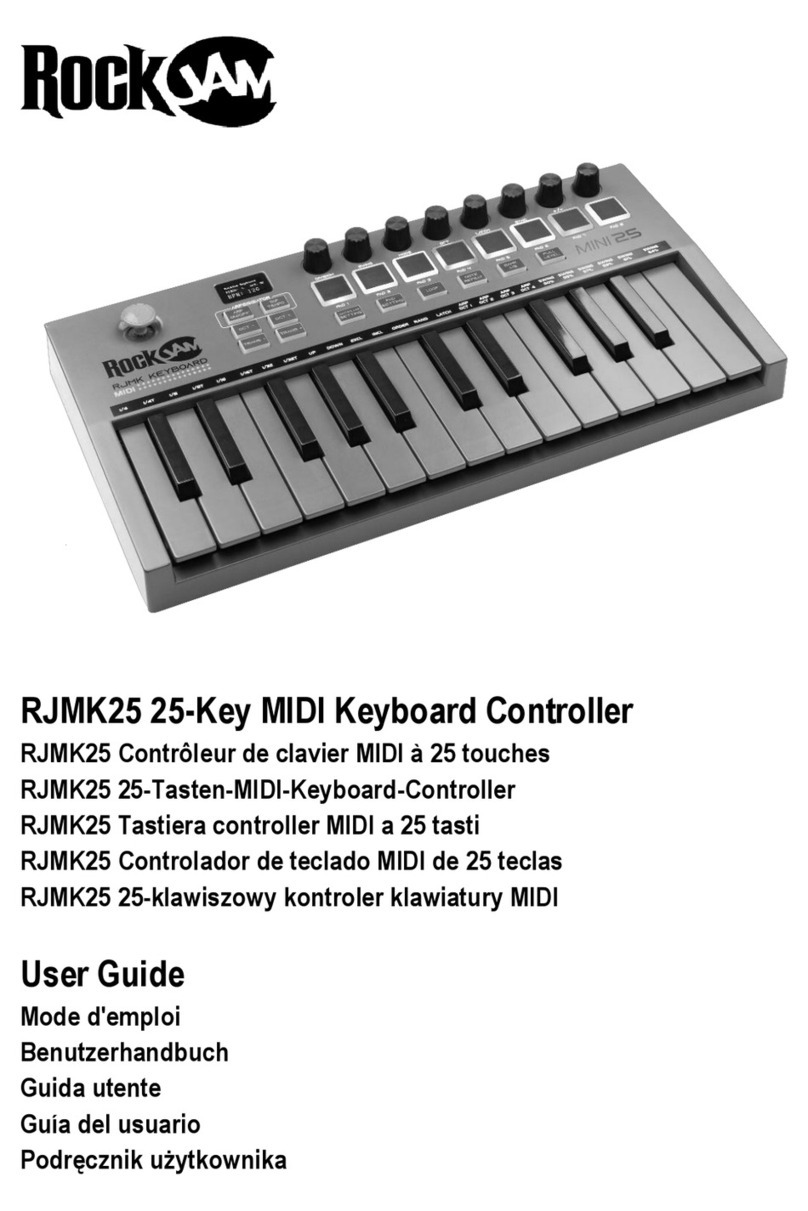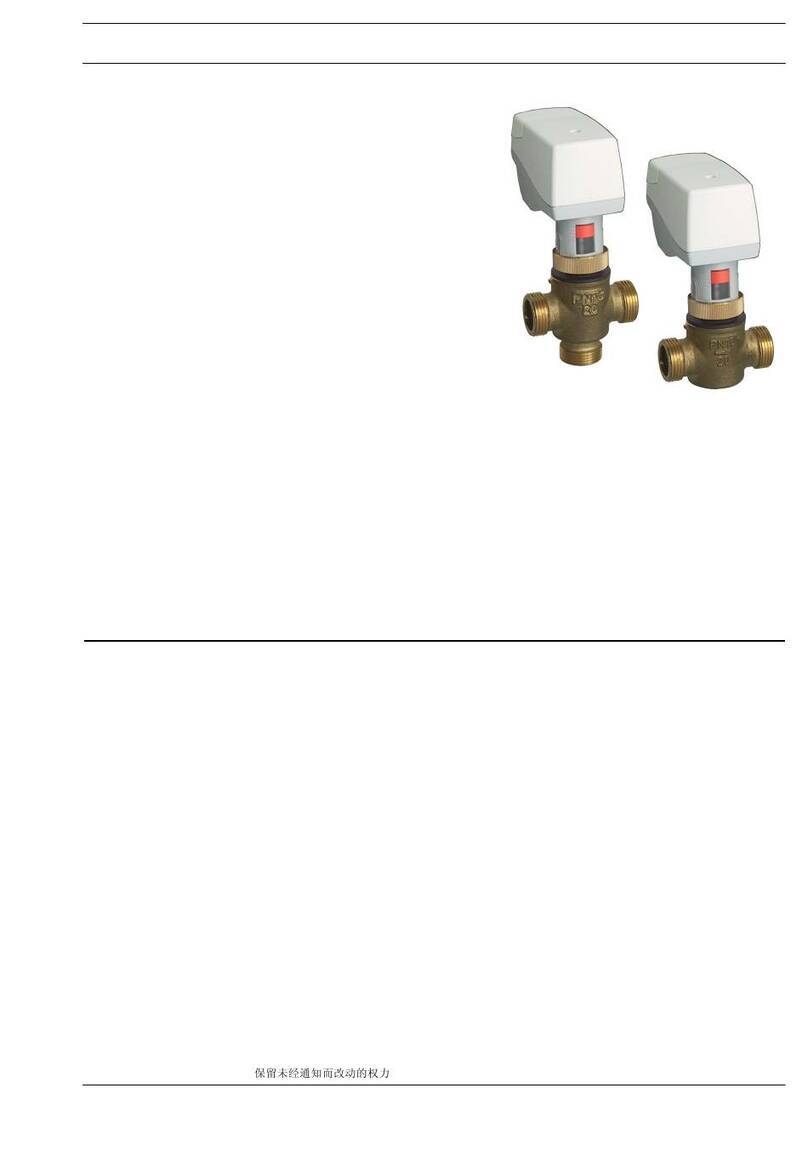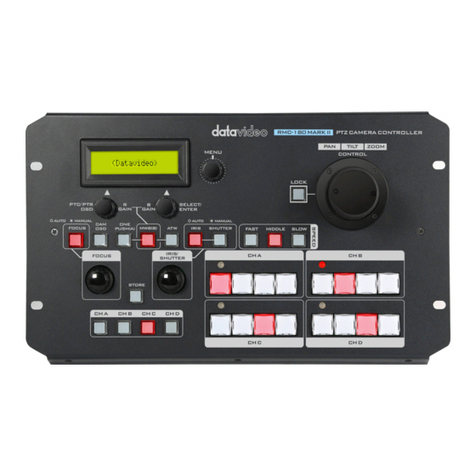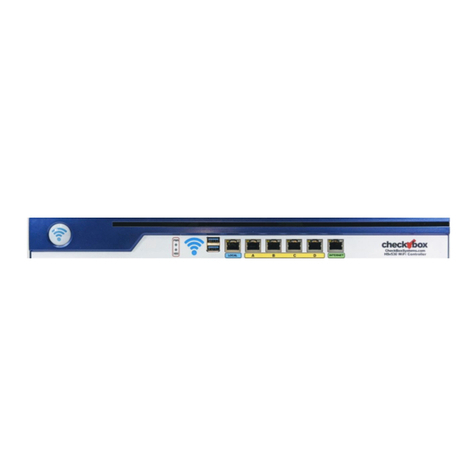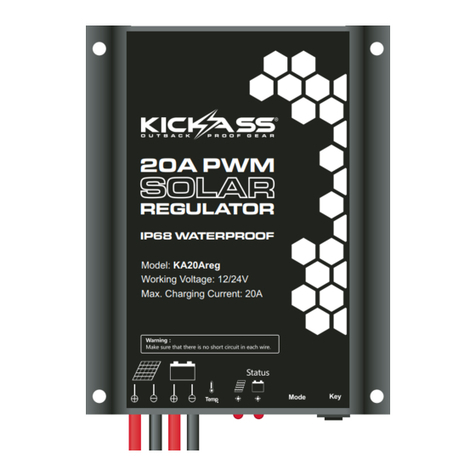Solcon HRVS-DN series User manual

H
HR
R
V
VS
S-
-D
DN
N
M
Me
ed
di
iu
um
m
V
Vo
ol
lt
ta
ag
ge
e
D
Di
ig
gi
it
ta
al
l
S
So
of
ft
t
S
St
ta
ar
rt
te
er
r
6
60
0-
-1
1,
,2
20
00
0A
A,
,
2
2,
,3
30
00
0-
-1
15
5,
,0
00
00
0
V
V
I
In
ns
st
t
r
ru
uc
ct
ti
io
on
n
a
an
nd
d
C
Co
om
mm
mi
is
ss
si
io
on
ni
in
n
g
g M
Ma
an
nu
ua
al
l
Ver.27/12/2010

2 • List of Figures
_____________________________________________________________________________________________
HRVS-DN Instruction and Commissioning Manual
Table of Contents
1.List of Figures...........................................................................................................................6
2.Safety & Warnings ....................................................................................................................8
2.1Safety..........................................................................................................................................8
2.2Attention......................................................................................................................................8
2.3Warnings.....................................................................................................................................8
3.Introduction...............................................................................................................................9
3.1Why Solcon? Why Soft Starters?................................................................................................9
3.2How Soft Starters Work? ..........................................................................................................10
Main Features, Options and Advantages ........................................................................................11
4.Technical Data ........................................................................................................................13
4.1HRVS-DN IP00 Unit (OEM Kit).................................................................................................13
4.2Typical Connection of the HRVS-DN IP00 Unit (OEM Kit) .......................................................14
4.3Typical Connection of the HRVS-DN in a Cabinet....................................................................15
4.3.1Typical Connection of HRVS-DN up to 6.6kV ...............................................................15
4.3.2Typical Connection of HRVS-DN from 10kV and up.....................................................16
4.4HRVS-DN Selection..................................................................................................................17
4.4.1Motor Current and Starting Conditions..........................................................................17
4.4.2PIV (Peak Inverse Voltage)...........................................................................................17
4.4.3Rated Currents Frame Sizes.........................................................................................18
4.5Ordering Information.................................................................................................................19
4.5.1Ordering IP00 Unit (OEM kit) ........................................................................................19
4.5.2Ordering a Cabinet Installed Soft Starter ......................................................................21
4.6Power Connections Description................................................................................................23
4.7Control Connections Description ..............................................................................................24
4.7.1Input Terminal 7 - Test/Reset/MULTI SOFT STOP.......................................................30
4.7.2Input Terminal 8 - Dual Adjust/Reset ............................................................................30
4.7.3Output Terminals 10, 11 & 12 – Immediate/# Strts PreAlarm .......................................30
5.Recommended Wiring Diagrams ..........................................................................................31
5.1Control Supply and Control Inputs From a Single Source ........................................................31
5.2Separate Sources for Control Supply and Control Inputs.........................................................31
5.3Three Separate Sources for Control Supply and Control Inputs...............................................32
5.4Soft Start and Immediate Stop (No Soft Stop)..........................................................................32
5.5Soft Start and Soft Stop wiring..................................................................................................33
5.6Soft Start, Soft Stop and Immediate Stop Wiring......................................................................33
5.7Soft Start, Soft Stop and Stop...................................................................................................34
5.8External Fault............................................................................................................................34
5.9Dual Adjustment (Control Input #8)...........................................................................................34
5.10Bypass Contactor......................................................................................................................35
5.11Operating via Communication Links .........................................................................................36
5.12Control Input #7 ........................................................................................................................37
5.13Control Input #8 ........................................................................................................................37
6.Installation of IP00 (OEM Kit) in a Cabinet ...........................................................................38
6.1Mounting ...................................................................................................................................38
6.1.1Low Voltage Section......................................................................................................39
6.2Temperature Range & Heat Dissipation ...................................................................................39
6.3Control Module Main PCB and Optional PCBs.........................................................................40
6.4Dip Switch Settings on the Main PCB.......................................................................................40
6.4.1Switch # 1 – Display Modes ..........................................................................................40
6.4.2Switch # 2 – Tacho Feedback (0-10VDC).....................................................................41
6.4.3Switches # 4, 5 & 6 – Language Selection...................................................................41
6.4.4Switch # 7 – Extended Settings.....................................................................................42
6.4.5Switch # 8 – Software Lock...........................................................................................42
6.5Analog I/O (Option 5) (Terminals Gnd, Out (-), Out (+)) ..........................................................43

3 • List of Figures
_______________________________________________________________________________________________
6.6Insulation test (Option 4) (Terminals 25, 26, 27 and Leak).....................................................44
6.7Remote Key-Pad Installation ....................................................................................................45
7.Control Keypad .......................................................................................................................47
7.1LCD Arrangement.....................................................................................................................47
7.2Push-Buttons ............................................................................................................................47
7.3Status LEDs..............................................................................................................................48
7.4Reviewing and Modifying Parameters ......................................................................................48
7.5Upon first Control Voltage Connection......................................................................................48
7.6Special Actions Performed in TEST/MAINTENANCE Mode ....................................................48
7.6.1Run Self Test.................................................................................................................48
7.6.2View Software Version ..................................................................................................49
7.6.3Obtain Default Parameters............................................................................................49
7.6.4Reset Statistical Data....................................................................................................49
7.6.5Calibrate Voltage and Current (Factory Use Only!).......................................................50
7.6.6Setting Time and Date...................................................................................................50
7.7Mode Pages..............................................................................................................................51
7.8Overview of All Mode Pages and Factory Defaults...................................................................52
7.8.1Display Mode – Page 0 .................................................................................................54
7.8.2Main & Protect. – Page 1 ..............................................................................................55
7.8.2.1Tripping Curves of the Integrated Overload Protection ..........................................58
7.8.3Start Parameters – Page 2............................................................................................60
7.8.3.1Soft Start Parameters.............................................................................................65
7.8.3.2Special Control for Synchronous Motors Excitation ...............................................66
7.8.4Stop Parameters – Page 3............................................................................................67
7.8.4.1Soft Stop Parameters .............................................................................................68
7.8.5Dual Adjustment Parameters – Page 4.........................................................................70
7.8.6Fault Parameters – Page 5 ...........................................................................................71
7.8.7I/O Programming Parameters – Page 6........................................................................73
7.8.7.1Terminal 7 and 8 Programming..............................................................................74
7.8.8Comm. Parameters – Page 7 – With the Optional Modbus PCB ..................................75
7.8.9Comm. Parameters – Page 7 – With the Optional Profibus PCB..................................75
7.8.10Comm. Parameters – Page 7 – With the Optional DeviceNet PCB ..............................76
7.8.11Statistical Data – page 8 ...............................................................................................77
8.Motor and Soft Starter Protection .........................................................................................78
8.1Adjustable Protection Functions ...............................................................................................78
8.1.1UNDER CURRENT .......................................................................................................78
8.1.2O/C –SHEAR PIN..........................................................................................................78
8.1.3OVERLOAD ..................................................................................................................78
8.1.4UNBALANCE CURRENT..............................................................................................78
8.1.5GROUND FAULT..........................................................................................................78
8.1.6UNDER/NO VOLTAGE .................................................................................................79
8.1.7OVER VOLTAGE ..........................................................................................................79
8.1.8LONG START TIME......................................................................................................79
8.1.9OPEN BYPASS.............................................................................................................79
8.1.10SET CURVE TO 0.........................................................................................................79
8.1.11PWR ON & NO STRT ...................................................................................................79
8.1.12MOTOR INSULATION ..................................................................................................79
8.1.13PHASE SEQUENCE.....................................................................................................79
8.1.14TOO MANY STARTS....................................................................................................80
8.1.15MODBUS TIME OUT ....................................................................................................80
8.1.16SET TIME & DATE........................................................................................................80
8.1.17COAST DOWN TIME....................................................................................................80
8.2Non Adjustable Protection Functions........................................................................................80
8.2.1UNDER/OVER FREQUENCY.......................................................................................80
8.2.2PHASE LOSS................................................................................................................80
8.2.3WRONG PARAMETERS ..............................................................................................80
8.2.4STORAGE ERROR.......................................................................................................80
8.2.5S. SCR OR WR. CON ...................................................................................................81
8.2.6OVER TEMPERATURE ................................................................................................81

4 • List of Figures
_____________________________________________________________________________________________
8.2.7EXTERNAL FAULT 1 & EXTERNAL FAULT 2 ............................................................81
8.2.8COMM. PORT FAILED .................................................................................................81
8.3Fault and Reset ........................................................................................................................81
8.4Auto Reset ................................................................................................................................82
8.5Timing Occurrence Table..........................................................................................................82
9.Packing, Storage, Handling and Assembly..........................................................................84
9.1Packing Specification................................................................................................................84
9.2Storage .....................................................................................................................................84
9.3Handling....................................................................................................................................84
9.4Soft starter’s Assembly Procedure:...........................................................................................85
9.4.1Mechanical Assembly....................................................................................................85
9.4.2Power and Control Cable Connections .........................................................................86
9.4.3Power Cables Connection.............................................................................................86
10.Commissioning and Operation Manual ................................................................................87
10.1Operational notes......................................................................................................................87
10.2Parts Identification in the HRVS-DN Cabinet............................................................................88
10.2.1Parts Identification in the HRVS-DN Cabinet (HRVS-DN up to 6.6kV) .........................88
10.2.2Parts Identification in the HRVS-DN Cabinet (HRVS-DN from 10kV and up) ...............90
10.2.3Low Voltage Compartment............................................................................................92
10.2.4Fuses.............................................................................................................................93
10.3Standard Control Diagram ........................................................................................................95
10.3.1How Does it Operate?...................................................................................................98
11.High-Pot Test of the HRVS-DN Cabinet ..............................................................................100
11.1High-Pot Test in HRVS-DN up to 6.6kV, EPT-Tx Connected.................................................100
11.2High-Pot Test in HRVS-DN up to 6.6kV, EPT-Tx Not Connected ..........................................101
11.3High-Pot Test in HRVS-DN from 10kV and Up, EPT-Tx Connected ......................................103
11.4High-Pot Test in HRVS-DN from 10kV and Up, EPT-Tx Not Connected................................104
12.Test Procedure for Low Voltage Testing............................................................................106
12.1Accessories Required for LOW VOLTAGE Testing of the Starter and Cabinet......................106
12.2Notes and Warnings ...............................................................................................................106
12.3Low Voltage Test Procedure...................................................................................................107
12.3.1Current Gain Dip Switches Setting..............................................................................110
12.3.2Test Harness Installation.............................................................................................110
12.3.2.1Test Harness Installation in HRVS-DN up to 6.6kV .............................................110
12.3.2.2Test Harness Installation in HRVS-DN from 10kV and up ...................................111
13.Start Procedure for Medium voltage Motor........................................................................112
13.1Special Attention Notes...........................................................................................................112
13.2Prior to Commissioning in Medium Voltage............................................................................112
13.3Medium Voltage Test Procedure ............................................................................................113
13.4Standard Starting Process......................................................................................................
114
13.5Examples of Starting Curves ..................................................................................................115
13.5.1Light Loads - Pumps, Etc. ...........................................................................................115
13.5.2High Inertia Loads: Crushers, Centrifuges, Mixers, Etc. .............................................115
13.5.3Special Starting Using DUAL ADJUSTMENT .............................................................116
13.5.3.1Special Starting – Using DUAL ADJUSTMENT – Wiring Diagram ......................117
13.5.4Choosing a Suitable Pump Curve (Centrifugal Pumps) ..............................................117
13.5.4.1Starting Curve ......................................................................................................117
13.5.4.2Stopping Curve.....................................................................................................117
13.5.4.3FINAL TORQUE During Soft-Stopping a Pump Motor.........................................118
13.6How to set MPS-3000 and DPM-10 when installed with HRVS-DN .......................................118
14.Trouble Shooting ..................................................................................................................120
14.1In-Out Resistance and Cathode-Cathode Resistance............................................................120
14.2Rgk (thyristors Gate-Cathode) Resistances. ..........................................................................120
14.3Firing Test...............................................................................................................................121
14.4Low Voltage Test Trouble Shooting........................................................................................123

5 • List of Figures
_______________________________________________________________________________________________
14.5Medium Voltage Trouble shooting ..........................................................................................127
15.Spare Parts............................................................................................................................130
16.HRVS-DN Communication (ModBus Protocol) ..................................................................131
16.1Introduction .............................................................................................................................131
16.2Basic Structure of the Serial Link Frame ................................................................................132
16.3SYNC (Silent Interval).............................................................................................................132
16.4Serial Link No. (Slave Address).............................................................................................132
16.5Function ..................................................................................................................................132
16.6List of Functions Supported By The HRVS-DN ......................................................................133
16.7Actual Data (3X References & 4X references) .......................................................................135
16.8Parameter Settings (4X References)......................................................................................138
16.9Control Register Write (4X Reference) ...................................................................................142
16.10Discrete Commands (Coils, 0x References)......................................................................143
16.11Discrete Hardwired Inputs (1x References).......................................................................146
16.12Diagnostics .........................................................................................................................146
16.13Exception Responses .........................................................................................................147
17.HRVS-DN Communication (Profibus protocol)..................................................................149
17.1Global Parameters:.................................................................................................................149
17.2Operation Mode in PROFIBUS:..............................................................................................149
17.3Description of the DPV0 (Cyclic) Frame: ................................................................................149
17.3.1Structure of the HRVS-DN Receiving Frame ..............................................................150
17.3.2Structure of the HRVS-DN Transmitting Frame ..........................................................150
17.3.3Choosing the Receiving DPV0 Registers....................................................................150
17.3.3.1Selection of the DPV0 Registers by the GSD ......................................................151
17.3.3.2Selection of the DPV0 Registers through Data Request (DPV1) .........................151
17.3.3.3Reading of the DPV0 (Cyclic) Registers via Data Request (DPV1) .....................153
17.4Operations that are Available in DPV1 ...................................................................................154
17.4.1Read and Write from Random Registers via Data Request........................................154
17.5Configure the PROFIBUS in the HRVS-DN............................................................................156
17.6Watch Dog Definition ..............................................................................................................156
17.7Numbers of actual data Register for (decimal) .......................................................................157
17.8Number of Setting Registers for Data Request.......................................................................161
17.8.1Main & protect. parameters.........................................................................................161
17.9Start Parameters.....................................................................................................................161
17.10Stop Parameters.................................................................................................................162
17.11Dual Adjust Parameters......................................................................................................162
17.12Fault Parameters ................................................................................................................162
17.13I/O Programming ................................................................................................................
162
17.14Communication Parameters ...............................................................................................162
17.15Time Parameters ................................................................................................................163
18.HRVS-DN Communication (DeviceNet™)...........................................................................164
18.1Introduction .............................................................................................................................164
18.1.1Overview .....................................................................................................................164
18.1.2Definitions....................................................................................................................164
18.1.3Reference Documents.................................................................................................164
18.1.4Open DeviceNet Vendor Association, Inc. (ODVA).....................................................164
18.1.5Rotary Switch Configuration........................................................................................164
18.1.6LED Indicators.............................................................................................................165
18.2Identity Object (01HEX - 1 Instance) ......................................................................................166
18.2.1Class Attributes (Instance 0) .......................................................................................166
18.2.2Instance Attributes (Instance 1)...................................................................................166
18.2.3Common Services.......................................................................................................166
18.3Message Router Object (02HEX - 1 Instance)........................................................................166
18.4DeviceNet Object (03HEX - 1 Instance) .................................................................................166
18.4.1Class Attributes (Instance 0) .......................................................................................166
18.4.2Instance Attributes (Instance 1)...................................................................................166
18.4.3Common Services.......................................................................................................166

6 • List of Figures
_____________________________________________________________________________________________
18.5Assembly Object (04HEX –4 Instances)................................................................................167
18.5.1Class Attributes (Instance 0) .......................................................................................167
18.5.2Output (O2T) Instance Attributes – Register 40752 ....................................................167
18.5.2.1Output Instance 112 (0x70 – Attribute 3) – Control Output ..................................167
18.5.3Input (T20) Instance Attributes – Register 40257........................................................167
18.5.3.1Input Instance 60 (0x3C) – Basic Softstart Input..................................................167
18.5.3.2Input Instance 61 (0x3D) – Extended Softstart Input ...........................................167
18.5.3.3Input Instance 100 (0x64) – Status ......................................................................168
18.5.4Common Services.......................................................................................................168
18.6Connection Object (05HEX –2 Instances) .............................................................................168
18.6.1Class Attributes (Instance 0) .......................................................................................168
18.6.2Instance Attributes (Instances 1-2) Explicit, Polled I/O ...............................................168
18.6.3Common Services.......................................................................................................169
18.7Softstart Object (2DHEX - 1 Instance) ....................................................................................169
18.7.1Class Attributes (Instance 0) .......................................................................................169
18.7.2Instance Attributes (Instance 1)...................................................................................169
18.7.2.1Extended AtReference Values .............................................................................169
18.7.2.2Extended StartMode Values.................................................................................169
18.7.3Common Services.......................................................................................................170
18.8Control Supervisor Object (29HEX - 1 Instances) ..................................................................170
18.8.1Class Attributes (Instance 0) .......................................................................................170
18.8.2Instance Attributes (Instance 1)...................................................................................170
18.8.3Common Services.......................................................................................................170
18.9Modbus / Serial Object (65HEX –1 Instance) ........................................................................170
18.9.1Class Attributes (Instance 0) .......................................................................................170
18.9.2Instance Attributes (Instance 1)...................................................................................170
18.9.3Common Services.......................................................................................................171
18.10Solcon Input Object (70HEX –1 Instance) .........................................................................171
18.10.1Class Attributes (Instance 0) .......................................................................................171
18.10.2Instance Attributes (Instance 1)...................................................................................171
18.10.3Common Services.......................................................................................................173
18.11Main Parameter Object (71HEX –1 Instance) ...................................................................173
18.11.1Class Attributes (Instance 0) .......................................................................................173
18.11.2Instance Attributes (Instance 1)...................................................................................173
18.11.3Common Services.......................................................................................................174
18.12Start Settings Object (72HEX –1 Instance) .......................................................................174
18.12.1Class Attributes (Instance 0) .......................................................................................174
18.12.2Instance Attributes (Instance 1)...................................................................................174
18.12.3Common Services.......................................................................................................175
18.13Stop Settings Object (73HEX –1 Instance)........................................................................175
18.13.1Class Attributes (Instance 0) .......................................................................................175
18.13.2Instance Attributes (Instance 1)...................................................................................175
18.13.3Common Services.......................................................................................................175
18.14Dual Settings Object (74HEX –1 Instance)........................................................................175
18.14.1Class Attributes (Instance 0) .......................................................................................175
18.14.2Instance Attributes (Instance 1)...................................................................................175
18.14.3Common Services.......................................................................................................176
18.15Fault Settings Object (76HEX –1 Instance) .......................................................................176
18.15.1Class Attributes (Instance 0) .......................................................................................176
18.15.2Instance Attributes (Instance 1)...................................................................................176
18.15.3Common Services.......................................................................................................176
19.Parameters List.....................................................................................................................177
20.General Information: ............................................................................................................180
1. LIST OF FIGURES
Figure 1- HRVS-DN Cabinet Type IP31 (NEMA1) ............................................................................................ 10
Figure 2- HRVS-DN Chassis Type (IP00) ......................................................................................................... 10
Figure 3 - Principle Diagram of Digital Medium Voltage Soft Starter (Bypass Preparations not Shown) .......... 10
Figure 4 - Phase Control of the Line Voltage Using Semiconductor (SCR) Elements ...................................... 10

7 • List of Figures
_______________________________________________________________________________________________
Figure 5 – Voltage Increase ..............................................................................................................................10
Figure 6 – Torque Reduction.............................................................................................................................10
Figure 7 – Current Limit..................................................................................................................................... 10
Figure 8 – HRVS-DN IP00 Unit (OEM Kit) ........................................................................................................ 13
Figure 9 – Typical Connection of HRVS-DN IP00 Unit (OEM Kit)..................................................................... 14
Figure 10 – Typical Connection of HRVS-DN up to 6.6kV with Line Contactor and Bypass Contactor ............ 15
Figure 11 – Typical Connection of HRVS-DN from 10kV and up With Line Contactor and Bypass Contactor . 16
Figure 12 – HRVS-DN up to 6.6kV Power Section............................................................................................ 23
Figure 13 – Control Module Input/Output .......................................................................................................... 29
Figure 14 – HRVS-DN up to 6.6kV - Phase Disassembly Accessories............................................................. 38
Figure 15 - HRVS-DN Control Module .............................................................................................................. 40
Figure 16 – Optional Analog PCB ..................................................................................................................... 43
Figure 17 – Optional Insulation PCB Wiring ...................................................................................................... 44
Figure 18 – RU-7, Resistor Unit – Dimensional Drawing .................................................................................. 44
Figure 19 - Remote Key Pad, Connection Cable and Control Module. ............................................................. 45
Figure 20 - Remote Key Pad - Dimensions ....................................................................................................... 45
Figure 21 - Remote Key Pad - Mechanical Installation and Cut-out Dimensions............................................. 46
Figure 22 - HRVS-DN Control Keypad .............................................................................................................. 47
Figure 23 – Eye Bolts Location on Top of the Cabinet...................................................................................... 84
Figure 24 – Cabinet Lifting Using 4 Lifting Cables. Top angle, A, Should be ≤60° .......................................... 85
Figure 25 – Anchor Bolts Holes Location on the Base of the Cabinet at Level 0mm. ....................................... 85
Figure 26 – Power and Control Cables Penetration to the Cabinet at Level 75mm .......................................... 86
Figure 27 – Power Cables Connection and Control Cables Routing................................................................. 86
Figure 28 – HRVS-DN up to 6.6kV Standard Cabinet – One Line Diagram...................................................... 88
Figure 29 - HRVS-DN up to 6.6kV Standard Cabinet – Doors Closed.............................................................. 89
Figure 30 - HRVS-DN up to 6.6kV Standard Cabinet – Doors Open ................................................................ 89
Figure 31 – HRVS-DN from 10kV and up, Standard Cabinet – One Line Diagram .......................................... 90
Figure 32 - HRVS-DN from 10kV and up Standard Cabinet – Doors Closed.................................................... 91
Figure 33 - HRVS-DN from 10kV and up Standard Cabinet – Doors Open ...................................................... 91
Figure 34 - HRVS-DN Low Voltage Compartment ............................................................................................ 92
Figure 35 – Power Supply to Firing PCB (HRVS-DN Models up to 6600V). ..................................................... 93
Figure 36 – Power Supply to Firing PCB (HRVS-DN Models From 10000V and up)........................................ 94
Figure 37 – EPT-Rx Fuse Replacement Procedure .......................................................................................... 94
Figure 38 - HRVS-DN - Typical Control Wiring of Standard Cabinet ............................................................... 95
Figure 39 – HRVS-DN up to 6.6kV – Preparations for High-pot Test.............................................................. 100
Figure 40 – HRVS-DN up to 6.6kV – EPT-Tx not Connected Preparations for High-pot Test, Testing L1 ..... 101
Figure 41 – HRVS-DN up to 6.6kV – EPT-Tx not Connected Preparations for High-pot Test, Testing L2 ..... 102
+Figure 42 – HRVS-DN up to 6.6kV – EPT-Tx not Connected Preparations for High-pot Test, Testing L3 ... 102
Figure 43 – HRVS-DN from 10kV and Up – Preparations for High-pot Test................................................... 103
Figure 44 – HRVS-DN from 10kV and up, EPT-Tx not Connected, Preparations for High-pot Test, Testing L1
................................................................................................................................................................. 104
Figure 45 – HRVS-DN from 10kV and up, EPT-Tx not Connected, Preparations for High-pot Test, Testing L2
................................................................................................................................................................. 105
Figure 46 – HRVS-DN from 10kV and up, EPT-Tx not Connected, Preparations for High-pot Test, Testing L3
................................................................................................................................................................. 105
Figure 47 – Current Gain Dip Switches Location ............................................................................................ 110
Figure 48 – HRVS-DN up to 6.6kV – EPT-Tx and Test Harness .................................................................... 111
Figure 49 – HRVS-DN From 10kV and up – EPT-Tx and Test Harness......................................................... 111
Figure 50 – Firing PCB – SCR#1 Gate-Cathode Testing ................................................................................ 120
Figure 51 – DPV0 parameters (Cyclic parameters)......................................................................................... 150
Figure 52 – Updating the register number that will show at DPV0 (by Data Request).................................... 152
Figure 53 – Reading the register number that is shown in the DPV0 (cyclic) list............................................ 153
Figure 54 – Choosing register number 80 hex ................................................................................................ 154
Figure 55 – Reading 4 following register by Data Request (DPV1) ................................................................ 155
Figure 57 - Data rate (Baud rate) rotary switch layout..................................................................................... 165

8 • Safety & Warnings
_____________________________________________________________________________________________
2. SAFETY & WARNINGS
2.1 Safety
1 Read this manual carefully before operating the equipment and follow its
instructions.
2 Installation, operation and maintenance should be in strict accordance
with this manual, national codes and good practice.
3 Installation or operation not performed in strict accordance with these
instructions will void manufacturer’s warranty.
4 Disconnect all power inputs before servicing the soft starter and/or the
motor.
5 After installation, check and verify that no parts (bolts, washers, etc.)
have fallen into the Power Section (IP00) of the HRVS-DN.
2.2 Attention
1 This product was designed for compliance with IEC 60947-4-2 for class A
equipment and EN 50178.
2 For further information, see the Technical Specifications.
2.3 Warnings
1
Internal components and PCBs are at mains potential when the HRVS-
DN is connected to mains. This voltage is extremely dangerous and
contact with it will cause death or severe injury.
2
When the HRVS-DN is connected to mains full voltage may appear on
the HRVS-DN’s output terminals and motor’s terminals, even if control
voltage is disconnected and motor is stopped.
3 The HRVS-DN must be grounded to ensure correct operation, safety and
to prevent damage.
4
Check that power factor capacitors are not connected to the output side
of the HRVS-DN (U, V, W).
Also make sure that power factor capacitors are not connected to the
bypass preparation bus bars (L1B, L2B, L3B when exist)
The company reserves the right to make any improvements or modifications to its products without
prior notice.

9 • Introduction
_______________________________________________________________________________________________
3. INTRODUCTION
3.1 Why Solcon? Why Soft Starters?
Three-phase AC induction motors are commonly used in a wide variety of drive applications. Due to their
starting characteristics, in many cases these motors cannot be connected directly to the power supply system.
When starting Direct On Line (DOL) the motor can see a very high surge current reaching up to 6 times (and
more…) the rated motor current. This excessive current puts stress on the supply system and the switchgear.
Also, when starting DOL, a very high peak torque can occur, stressing the driven motor and the mechanical
system including auxiliary power transmission parts (V-belt, gears, etc.).
There are several methods for reducing the damaging effects of this excessive starting current. Conventional
methods include reactors and autotransformers. But these methods only allow the voltage to be reduced in
steps whereas a soft starter provides step-free acceleration of the drive system by continuously increasing the
voltage over a selected period of time. This approach to starting minimizes the effect of high inrush current on
the supply system, the motor and the driven load.
Soft starters provide the following benefits:
Reduced starting current, eliminates voltage drops and dips of the supply network
Smoother acceleration of loads, eliminates process or product damage
Extended lifetime of all mechanical components, e.g. eliminates gearbox damage and results in less
maintenance & downtime
Extended motor life
Reduced maintenance and operating costs
The HRVS-DN soft starter represents a logical extension of the Solcon soft starter product range into medium
voltage applications.
With HRVS-DN, Solcon presents an innovative standard product that provides a flexible, low cost alternative
to fixed speed (DOL) starting.
Designed for use with standard medium voltage three-phase squirrel cage induction motors as well as
synchronous motors, this high-performance digital soft starter ensures smooth acceleration and deceleration.
HRVS-DN is available in all standard internationally recognized medium voltage ratings: 2.3kV, 3.3kV, 4.16kV,
6kV and 6.6kV, 10kV, 11kV, 13.2kV, 13.8kV and 15kV.
The standard current output range capability is from 200kW to 27MW.
HRVS-DN is designed and built to meet international standards including:
• IEC • EN • DIN VDE • NEMA • UL/CUL • IEEE
The HRVS-DN soft starters are manufactured at the highest quality level. The entire design, production and
delivery process, (i.e. construction, manufacturing, order processing and logistics delivery center) have been
certified DIN ISO 9001.2000.
The enclosed versions of the HRVS-DN are provided as ready-to-connect cabinet enclosed type units
(example shown in Figure 1) or - for OEM only - chassis type OEM kits (example shown in Figure 2) are
available for building into custom enclosures or other relevant equipment (note: the complete interface
engineering is the responsibility of the user).

10 • Introduction
_____________________________________________________________________________________________
Figure 1- HRVS-DN Cabinet Type IP31 (NEMA1)
Figure 2- HRVS-DN Chassis Type (IP00)
3.2 How Soft Starters Work?
By using thyristors (SCRs) in a phase angle control mode, reduced voltage control can be achieved. Phase
control makes it possible to gradually increase the motor terminal voltage from an initial set point up to the
system supply voltage level. The related starting current and the starting torque can be optimally adjusted to
the motor/load conditions.
Figure 5 shows a principal voltage increase curve.
Figure 6 demonstrates the torque reduction compared to the DOL torque. Figure 7 demonstrates typical
behavior of motor current.
Figure 5 – Voltage Increase
Figure 6 – Torque Reduction
Figure 7 – Current Limit
In addition, the Solcon HRVS-DN soft starters provide the "soft stopping" function as a standard feature.
Similar to the reduced voltage start, a stop command gradually reduces the motor voltage over time until the
motor stops. Abrupt stopping is avoided, a specific advantage in pumping applications to prevent the
damaging effects of water hammer and on conveyor belts where the load may be damaged by an abrupt stop.
Figure 3 - Principle Diagram of Digital Medium Voltage Soft
Starter (Bypass Preparations not Shown)
Figure 4 - Phase Control of the Line Voltage Using
Semiconductor (SCR) Elements

11 • Introduction
_______________________________________________________________________________________________
Main Features, Options and Advantages
Advantages at a Glance
❍Complete line of 60-1,200A, 2,300-15,000V as
standard products
❍Customized soft starters (consult the factory
for details)
❍Heavy duty, fully rated design
❍Starting capacity of 400% of FLC for 30
seconds at a rated ambient temperature of 50°C
❍Preparation for bypass - to maintain protection
when bypass is closed
❍Robust construction
❍Superior starting & stopping characteristics
❍Comprehensive motor protection package
❍User friendly
❍Unique protection for corrosive environments
❍Generator ready - auto frequency tracking
❍Sustains variations of 45-65Hz while starting
❍Unique built in optional features including:
❍Motor insulation tester
❍Modbus / Profibus /DeviceNet comm.
❍Analog output
❍Relay PCB for comm. control
❍Tacho feedback
❍Multi-start (standard)and Multi-soft
stop (optional) capability
❍Synchronous motor excitation system
control
❍Remote display
Standard Ratings
❍2.3kV, 4.16kV, 6kV, 6.6kV, 10kV,11kV,
13.2kV, 13.8kV, 15kV
Starting & Stopping
❍Soft start & soft stop
❍Current limit
❍Pump control program
❍Torque and current control for optimized
starting & stopping process
❍Dual adjustments - two starting & stopping
characteristics
❍Advanced pulse start
❍Linear acceleration
Motor & Starter Protection
❍ Too many starts
Coast Down Time
❍ Long start time (stall)
❍ Shear-pin
❍ Electronic overload with selectable curves
according to IEC classes or NEMA classes
❍ Under current with adjustable delay
❍ Unbalance current with adjustable delay
❍ Ground fault with adjustable delay
❍ Phase loss & phase sequence
❍ Under, over & no voltage
❍ Load loss (motor not connected)
❍ Shorted SCR
❍ Starter over-temperature
Displays LCD & LEDs
❍ Illuminated LCD - 2 lines x 16 characters
❍ Selectable languages: English, German, French,
Spanish and Turkish (Chinese and Russian - optional)
❍ Two display modes for basic and advanced
applications
❍ Friendly operation with default parameters
❍ Eight LEDs for quick operational status
❍ Statistical data including:
❍ Total run time
❍ Total number of starts
❍ Total number of trips
❍ Last start current
❍ Last start time
❍ Last 10 trips with time stamp
❍ Current at trip

12 • Introduction
_____________________________________________________________________________________________
Unique Built-in Options
❍Analog output, related to the motor's current
or related to the motor’s rated power.
Programmable as 0-10VDC, 4-20mA, 0-20mA
❍Motor insulation test - a unique feature for
submersible pumps, motors installed in harsh
environments, etc
The system measures motor insulation when
motor is not running.
Two programmable levels are available:
❍ Alarm level, adjustable 0.2-5 Mohm
❍ Start disable level, adjustable 0.2-5Mohm,
preventing starting when insulation is below
acceptable levels
❍Special tacho feedback circuitry
❍Modbus RTU - enables setting, control &
supervision
❍Profibus DP – enables setting, control &
supervision
❍DeviceNet - enables setting, control &
supervision
❍Relay PCB – enables starting the application
when the soft starter is installed in a cabinet via
communication, and to control the excitation
system of a synchronous motor
❍Remote display allows the panel builder to
mount the keypad of the HRVS-DN in a remote
location of the Control Module. A standard length
of 1.5m cable length is supplied
❍Multi-soft stop special software allows to soft
stop motors when a multi-start application is
applied.
Unique External Options
❍Customized tailor-made design of a cabinet
❍Advanced motor protection MPS-3000
❍Digital multi-meter for advanced measurement
capabilities - DPM-10
❍Motor Insulation Protection – MIP-6 for
advanced tracking of motor insulation level over
more than 20 years
❍Line and Bypass Contactors/VCBs
❍Fuses and disconnectors
❍Capacitors for power factor correction
Auxiliary Relays
❍Three standard programmable relays (each relay
with one C.O. 8A, 220VAC contacts)
❍ Immediate with adjustable on and off delays
(can be dedicated for too many starts pre-alarm relay)
❍ End of Acceleration, with adjustable on delay
❍ Fault, programmable as fault or fault-fail safe
operation.
❍Low motor insulation alarm (optional relay)
Applications - Industrial
❍Pumps
❍Hydraulic systems
❍Fans and blowers
❍Compressors
❍Conveyors
Applications - Marine & Offshore
❍Water, ballast and fire-fighting pumps
❍Refrigeration chillers and compressors
❍Hydraulic pumps and power packs
❍Thrusters
❍Main propulsion motors

13 • Technical Data
_______________________________________________________________________________________________
4. TECHNICAL DATA
4.1 HRVS-DN IP00 Unit (OEM Kit)
Power Section and
Connection Harness
Control Module
Firing
Transformer
EPT-Tx and EPT-Rx
Figure 8 – HRVS-DN IP00 Unit (OEM Kit)
The IP00 unit (OEM kit) is available for building into custom enclosures or other relevant equipment.
It consists of the following (refer to Figure 8 above):
Power Section consists of the 3 identical phase stacks, firing PCBs, power supplies to the firing PCBs
(in HRVS-DN from 10kV and up power supplies to the firing PCBs are separated from the Power
Section), 3 CTs and the connection harness to the low voltage compartment (including copper wires
and fiber optic wires). The Power Section is installed in the medium voltage compartment of the
cabinet.
Control Module is the “brain” of the soft starter. It consists of the main CPU PCB, fireboard PCB,
power supply, optional PCBs (when ordered) and input/output interface terminals.
The Control Module for HRVS-DN is identical for all ratings and suitable for mounting in the L.V.
compartment of the cabinet which should be fully segregated from the M.V. compartment.
Interposing relays should be connected to all HRVS-DN auxiliary contacts, three relays must be
incorporated: Immediate, End of Acceleration and Fault.
Firing Transformer. This transformer is applicable for 115VAC or 230VAC control voltages.
For HRVS-DN controlled by DC control voltages - DC power supply is supplied – for details consult the
factory.
The Firing transformer is installed in the low voltage compartment of the cabinet and supplies control
power to the firing PCBs located in the Power Section of the HRVS-DN in the medium voltage
compartment of the cabinet.
EPT-Tx (transmitter) and EPT-Rx (receiver) are used instead of the traditional voltage transformer to
measure the input voltage.
The EPT-Tx is installed in the medium voltage compartment and is connected to the mains bus bars
downstream from the Line Contactor.
The EPT-Rx is installed in the low voltage compartment of the cabinet.
The EPT-Tx and EPT-Rx are connected by 2 fiber optic wires which are part of the connection
harness.

14 • Technical Data
_____________________________________________________________________________________________
4.2 Typical Connection of the HRVS-DN IP00 Unit (OEM Kit)
Figure 9 – Typical Connection of HRVS-DN IP00 Unit (OEM Kit)
Notes:
Figure 9 shows a typical connection of an HRVS-DN IP00 unit (OEM kit) of up to 6.6kV with a control voltage
of 115/230VAC. For connection diagrams for other models consult the factory.
L1B, L2B, L3B bus bars are only available in HRVS-DN up to 6.6kV.

15 • Technical Data
_______________________________________________________________________________________________
4.3 Typical Connection of the HRVS-DN in a Cabinet
4.3.1 Typical Connection of HRVS-DN up to 6.6kV
The HRVS-DN must be connected with a Line Contactor and a Bypass Contactor as demonstrated in Figure
10.
Figure 10 – Typical Connection of HRVS-DN up to 6.6kV with Line Contactor and Bypass Contactor

16 • Technical Data
_____________________________________________________________________________________________
4.3.2 Typical Connection of HRVS-DN from 10kV and up.
The HRVS-DN must be connected with a Line Contactor and a Bypass Contactor as demonstrated in Figure
11.
Figure 11 – Typical Connection of HRVS-DN from 10kV and up With Line Contactor and Bypass Contactor

17 • Technical Data
_______________________________________________________________________________________________
4.4 HRVS-DN Selection
The HRVS-DN should be selected in accordance with the criteria of motor current and starting conditions.
4.4.1 Motor Current and Starting Conditions
Select the HRVS-DN according to the motor's Full Load Ampere (FLA) - as indicated on its nameplate (even if
the motor will not be fully loaded).
Soft Starter Full Load Current (FLC) must be ≥Motor’s Full Load Ampere (FLA).
The HRVS-DN is designed to operate under the following maximum conditions:
Ambient
Temperature
[°C]
Max. Starting Current
[A]
Max. Starting
Time at 400%
FLC
[sec]
50 400%xFLC 30
Max. starts per hour: 2 starts per hour at maximum ratings.
4.4.2 PIV (Peak Inverse Voltage)
Thyristors PIV rating, internal circuitry and insulation define the following voltage levels:
2,300V, 3,300V, 4,160V, 6,600V, 10,000V, 11,000V, 13,800V and 15,000V.
Each soft starter is suitable for 50/60Hz.
PIV level is rated at 3 times the rated voltage or higher.

18 • Technical Data
_____________________________________________________________________________________________
4.4.3 Rated Currents Frame Sizes

19 • Technical Data
_______________________________________________________________________________________________
4.5 Ordering Information
4.5.1 Ordering IP00 Unit (OEM kit)
HRVS-DN (IP00) Internal Order
No: Rev.:
Solcon cat. No.:
Customer Name:
HRVS-DN
Rated
current Voltage
Control
voltage
supply
Control Input
supply Options Lexan
See below See below
115VAC
230VAC
110VDC
125VDC
220VDC
24VDC
115VAC
230VAC
110VDC
125VDC
220VDC
3M-Modbus
3P-Profibus
3D-DeviceNet
5-analog Card
D-remote display
RU-Russian characters.
ROC-Chinese characters
Relay-Relay PCB
NLR-Special software for
Multi soft stop applications
S
RU
N
No. Main Components Model - P/N QTY.
1.
2.
3.
4.
5.
6.
7.
8.
9.
10.
11.
MV Soft Starter Specification
No. ITEM Options Specify
1.
Mains Voltage
2300, 3300, 4160, 6000, 6600, 10000,11000 , 13200,
13800,15000
2.
Starter FLC (Amp.)
At 2300-4160V: 60,110, 200, 320, 400, 700, 800,1000, 1200
At 6000-15000V: 70,140,250,300,400,500,700,800,1000,
1200
3. Control Supply Voltage 115VAC, 230VAC, 110VDC, 125VDC, 220VDC, 24VDC
4. Control Input Voltage 115VAC, 230VAC, 110VDC, 125VDC, 220VDC, 24VDC/AC
5. Test Voltage 230, 400, 500, 600, 690
6. Control wires type
7. Harness Side Left/Right
8. Relay Card NO / YES
9. Analogue Output NO / YES
10. MODBUS Communication NO / YES
11. PROFIBUS Communication NO / YES
Project Name: Motor Name Plate:
Contact
Person: Application:
Tel: Qty:
Fax: Delivery:
E-mail: Order number

20 • Technical Data
_____________________________________________________________________________________________
MV Soft Starter Specification
No. ITEM Options Specify
12. DeviceNet Communication NO / YES
13. Insulation Test Module NO / YES
14. Optional loose
Components YES/NO
14.1 Extended Split Phase
14.2 Motor Protection Relay
(Refer to Relay Ordering
Information Data)
MPS-6 , MPS 3000-P/C
14.3 Digital Panel Meter DPM NO / YES
14.4 Line Contactor 2300-6600V
J.C. model
MVC/SVC/Toshiba model
CV-6HA
NO / YES (Voltage & Current per selected starter rating)
14.5 Bypass Contactor 2300-
6600V J.C. model
MVC/SVC/Toshiba model
CV-6HA
NO / YES (Voltage & Current per selected starter rating)
14.6 Auxiliary Contacts
14.7 Coil Control Voltage ACV:120,240 DCV:125,250
14.8 Line Contactor 7200-
12000V
Toshiba model CV-10HA
NO / YES (Voltage & Current per selected starter rating)
14.9 Bypass Contactor 7200-
12000V
Toshiba model CV-10HA
NO / YES (Voltage & Current per selected starter rating)
14.1 Auxiliary Contacts 4NO+3NC , 6NO+5NC
14.1 Coil Control Voltage ACV:110,115,120,125,220,230,240,380,400,415,440,500
DCV:24,60,110,124.220
14.1 MIP – Motor Insulation
Protection NO / YES
15. Packing Sea fright, Air fright, No
16. Labeling
17. Instruction Manuals
18. Ex-Factory Delivery
19. Ship to Box Marking
20. Special Notes
21. Spare Parts
1. 7.
2. 8.
3. 9.
4. 10.
5. 11.
6. 12.
Issued by: Date :
Approved by (Sales Manager) : Date :
Table of contents
Other Solcon Controllers manuals
Popular Controllers manuals by other brands
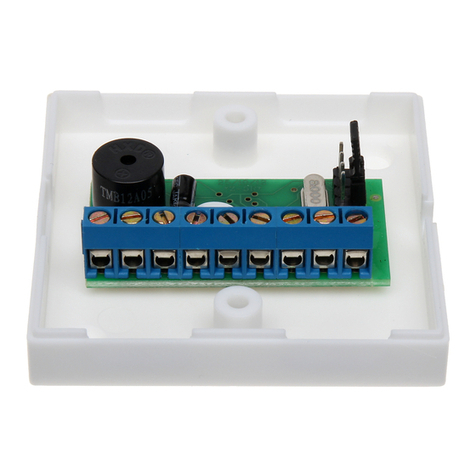
Iron logic
Iron logic Z-5R Relay Wiegand user manual
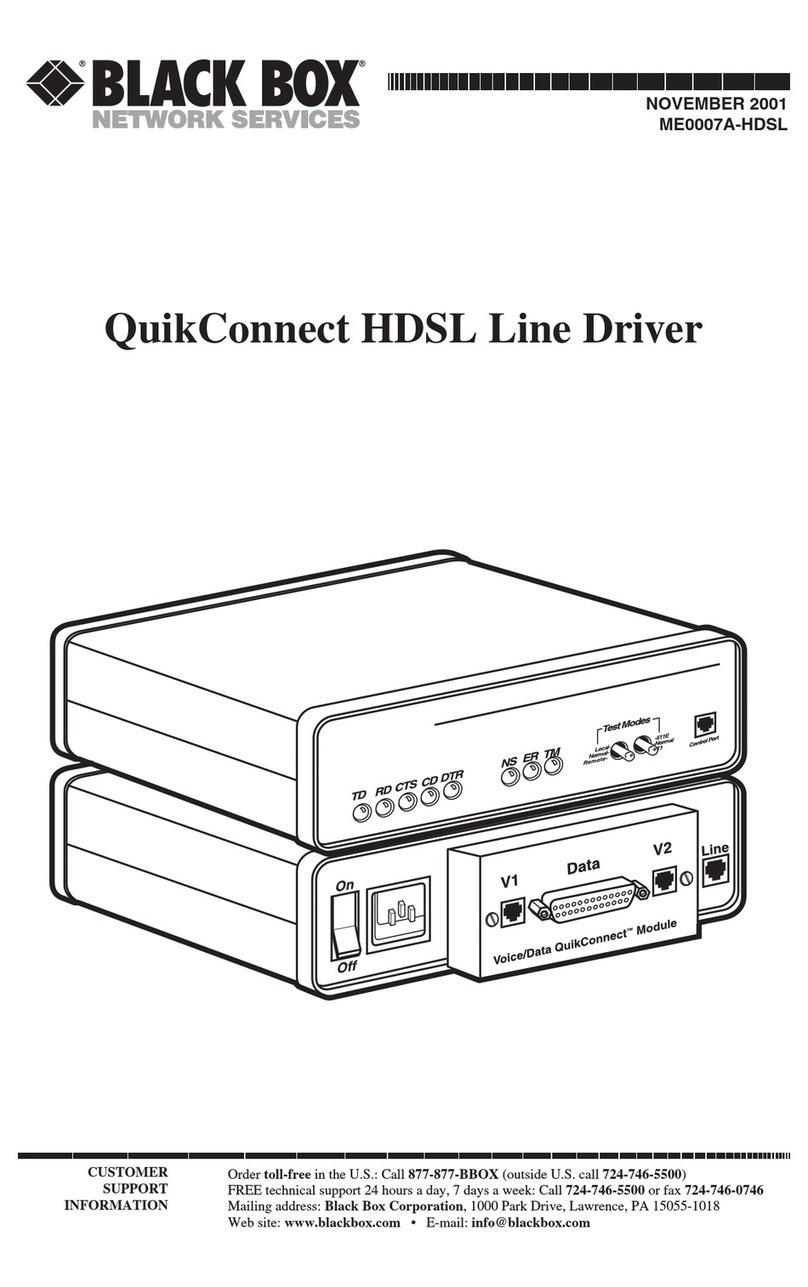
Black Box
Black Box QuikConnect ME0007A-HDSL manual
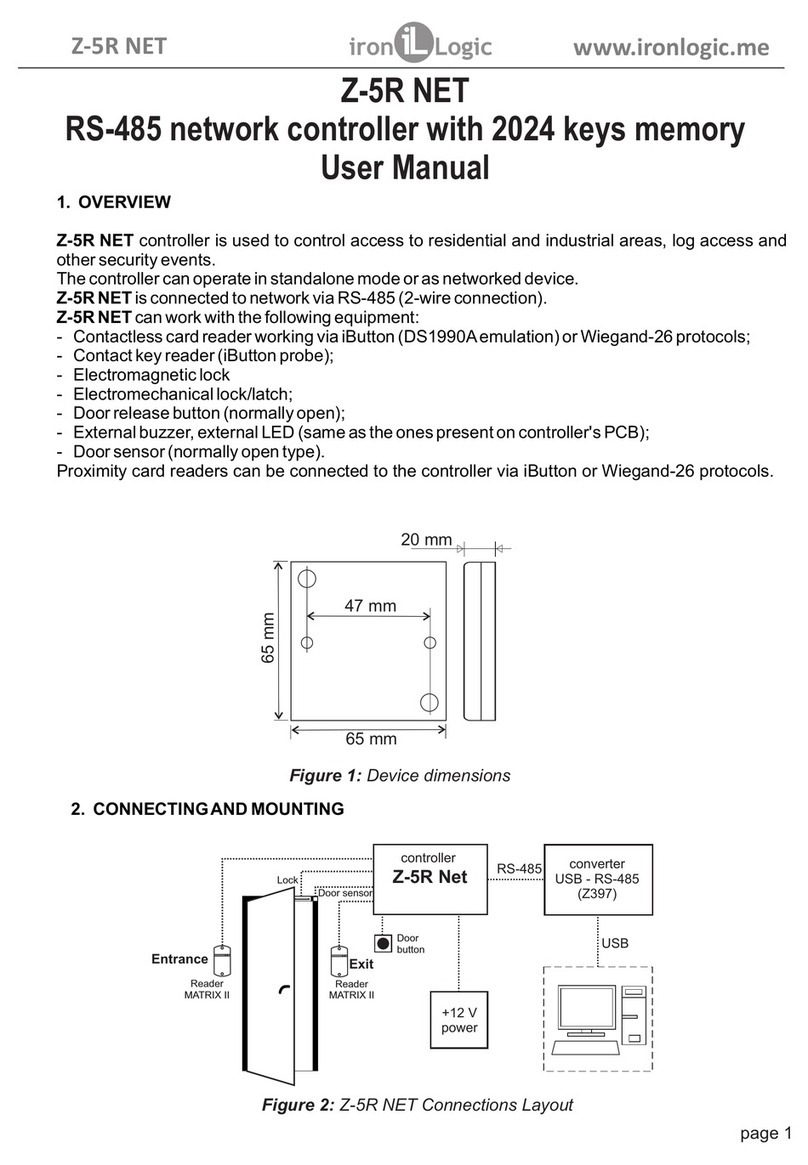
Iron logic
Iron logic Z-5R NET user manual
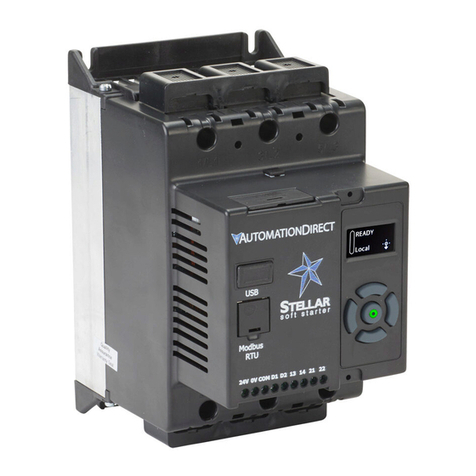
AutomationDirect
AutomationDirect Stellar SR35 Series quick start guide
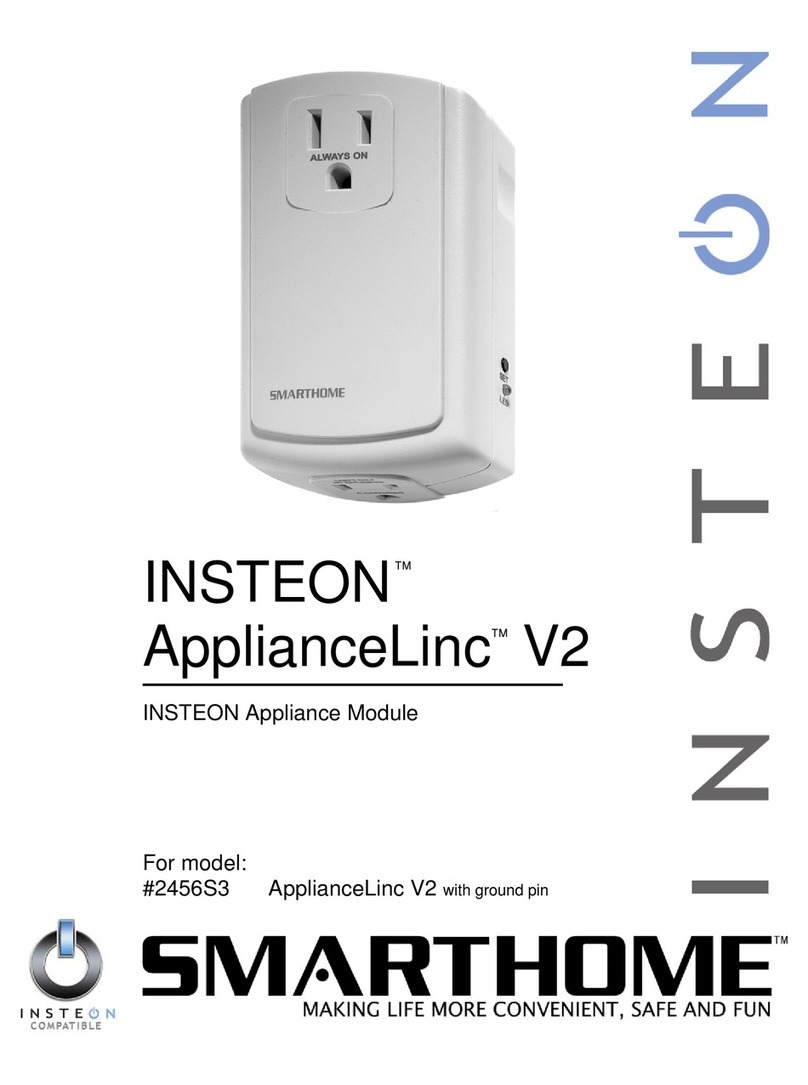
smart home
smart home ApplianceLinc V2 user guide
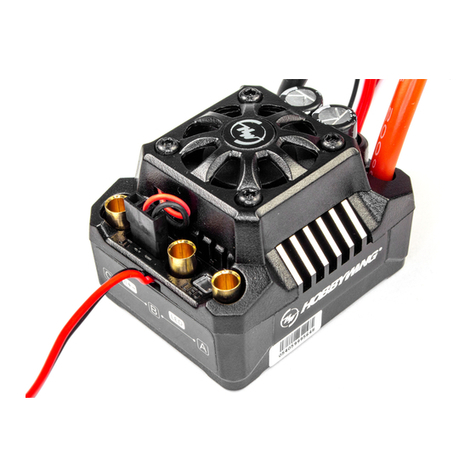
Hobby-Wing
Hobby-Wing EZRUN MAX10 SCT user manual
